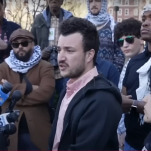What It Means to Build Beyond ‘Roe’
"We can learn a lot from past models of activism," Renee Bracey Sherman, co-author of Liberating Abortion, told Jezebel. “Everyone was having abortions freely until the institutions of colonialism, capitalism, policing."
Photo: Getty Images AbortionBooks
In Supreme Court Justice Samuel Alito’s opinion overturning Roe v. Wade in 2022, he wrote that “abortion is not deeply rooted in the Nation’s history and tradition.” But that’s just not true, according to authors Renee Bracey Sherman, a reproductive justice activist and founder of We Testify, and Regina Mahone, a journalist and senior editor at The Nation.
For as long as people have been getting pregnant, they’ve been having abortions. In their new book Liberating Abortion: Claiming Our History, Sharing Our Stories, and Building the Reproductive Future We Deserve, Bracey Sherman and Mahone dedicate an entire chapter to the delightful history of herbal abortions—in ancient Egypt, the Greek and Roman Empires, imperial China, African nations, Indigenous tribes, across Latin America, and pretty much anywhere or any time period you can think of, including the colonial United States. Thomas Jefferson and his daughter wrote letters about her decision to help her cousin procure one; Benjamin Franklin details homemade abortion methods in one of his books.
Explicit abortion bans and criminalization, Bracey Sherman told Jezebel, are a far newer invention in this country than abortion—both an invention of racist panics about the white birth rate and a conspiracy to control the bodies and lives of communities of color. “Everyone was having abortions freely until the institutions of colonialism, capitalism, policing—all rooted in white supremacy, all one and the same,” she said.
Liberating Abortion is simultaneously an introduction to a movement, and a call for seasoned reproductive rights and justice advocates to familiarize ourselves with often erased or white-washed histories and reimagine what’s possible. Today, activists and politicians center their abortion-related demands around restoring Roe, which was a precedent that still left thousands without convenient and affordable abortion access.
Bracey Sherman says the book is “a love letter to people who have abortions, about what you all deserve, our history as a community and diaspora, what we can build toward together—it’s about seeing yourself in history, so you can see yourself today, and the way forward.” Without Roe, we’re presented with a blank slate, an opportunity to establish a new framework for bodily autonomy and reproductive justice. But slogans like “Restore Roe” mean we’re fighting for crumbs. According to Bracey Sherman and Mahone, history tells us—shows us—that there’s a better way.
An abortion history lesson you won’t get in school
In the late 1800s and early 1900s, there were no clear laws governing abortion, and abortion providers of varying levels of expertise set up shop across the country. Explicit restrictions and eventual bans on abortion only started to materialize in the early 20th century, in large part because of racialized fear-mongering about unsafe abortions. Bracey Sherman and Mahone pored through hundreds of headlines and news clippings from that time period, which centered around salacious stories often about Black women dying from botched, back-alley abortions provided by Black abortion providers who faced arrest and incarceration for these outcomes. In North Carolina, a Black woman named Virginia King found herself in and out of jail for providing abortion services that led to at least two deaths in the early 1920s.
But fatal outcomes from medical procedures were more common during the 19th century, period. Until roughly 150 years ago, doctors didn’t even know they should be washing their hands between operations. “Like, Dr. Pepper and Coca-Cola were seen as medicine during this period,” Bracey Sherman said. “Of course, people were dying from abortions—they were dying from everything.”
This contributed to a cultural understanding in the early 1900s of abortion as dangerous, criminal, and, crucially, contained within Black communities. All of this intersected with rising tides of Christian nationalism, xenophobia, and white birth rate panics, as well as increased investments in policing. “Over and over, the throughline we kept seeing was whenever Black and brown people were getting free or gaining new rights, or there was more immigration, that’s when you’d see a backlash toward abortion,” Bracey Sherman said. “That was the pattern. That’s what we’re seeing today, with talk of birthright citizenship, the border, abortion bans at the same time. It’s connected—if you don’t have control over your own body, you don’t have control over anything, and they will use that to destroy everything else.”

From left to right: Bracey Sherman, the cover of Liberating Abortion, and Regina Mahone
In their book, Bracey Sherman and Mahone also walk us through the path that 20th-century reproductive rights activists and white feminists embarked on to win Roe in the 1970s. Initially, they sided with then-California Gov. Ronald Reagan to win legalized “therapeutic” abortions exclusively for people with specific emergency circumstances, should they sufficiently convince a medical board. Most of the activism during this period centered on stories of palatable white women who were being forced to travel to Mexico for abortion care.
-

-

-

-

-

-

-

-

-

-

-

-

-

-

-

-

-

-

-

-

-

-

-

-

-

-

-

-

-

-

-

-

-

-

-

-

-

-

-

-









































